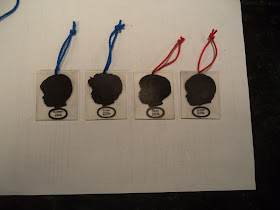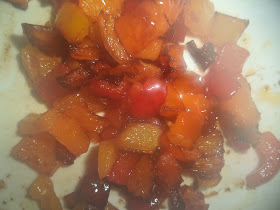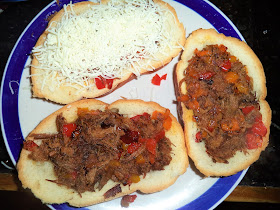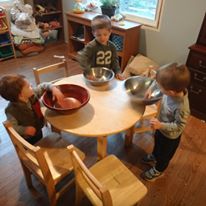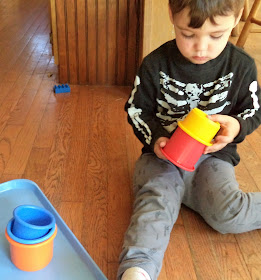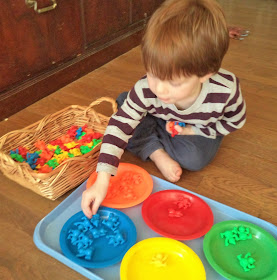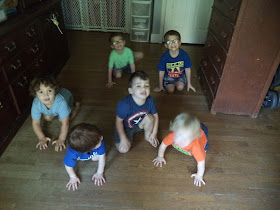We have 4 basic rules here:
- Respect others/living beings
- Respect things
- No running inside - walk
- No throwing inside
That's it. This is a child-led program, so they are pretty much free to do whatever they want as long as these basic tenants are adhered to for their activity choices.
When the usual discipline measures are not working to correct a behavior problem, then a discipline plan is often the key to getting it resolved. A discipline plan has similar elements to a curriculum plan, and the scientific process.
Identify the problem. Sometimes, the root problem is not what we are routinely addressing. We are reacting to symptoms, extensions, or outcomes, rather than the core issue.
Identify those involved. Protagonist? Victims? Home issues? ME? What is each one doing to contribute to the situation perpetuating?
Situation. When does it occur? Is it environmentally stimulated? Does it exacerbate at a particular time?
Review. What has been tried? Why has it failed? What has not yet been tried?
What is the goal? What is the single most important piece of this situation that needs to be addressed? What does the ideal outcome look like?
What can I change or teach that leads to the desired outcome/behavior?
Implement, review, tweak.
OVERVIEW:
I have a young gentleman, with a big heart and joyful personality, who has been unable to keep from running inside. He father told me it is the same at home. This child also has an issue of always needing to be first/in control. So when he ran, the others would run, and he would push them if it seemed possible they would get ahead of him. Running also leads to tripping, and tripping leads to falling. There's a reason for rules.
I had already tried:
- Repeating the rule
- Explaining the reasons behind the rule
- "Taking away his legs" where he had to sit on the floor or at a table and play
- Giving him 3 opportunities to choose an acceptable behavior [with above] other than running before time out was initiated
- Praising good behavior choices
The issue came to a head when he was basically going into time out within five minutes after getting out, sometimes he would RUN out of time out.
Then he started refusing to go into time out, which is basically the highest form of discipline I can use. Parents can also use segregation to a room, loss of toys/privileges/activities, etc. that are not feasible in a school/care environment at this age to the extent that it can make a difference.
I viewed this as a non-compliance issue. It devolved into a power play. He was going to run, and I was going to put him in time out for it, especially when he started taking out his frustration at the situation on the other children.
Obviously what I was doing was not working, and what he was doing was unacceptable.
I discussed it with the parents viewing this as a comprehensive issue for both family and school.
PLANNING PROCESS:
I could see this issue was not going to go away anytime soon, as I had been dealing with this for weeks, it was increasing, and it needed to be curbed immediately. It was a safety issue. Even if he was doing it at home, I needed a solution NOW for school.
Questions:
- Why is he running inside after spending a minimum of three hours outside in constant motion? Probably not getting enough high energy activity.
- What would I have done if he were younger? Environmental changes.
- What would I do if he were older? Same as I was doing: explain, offer 3 chances to choose the correct behavior, then time out, encouraging good choices.
- What is the goal? Stop running inside
I tried environmental changes. However, when they are older than two, they have the dexterity to move around obstacles with ease. Any further changes would block emergency paths. It almost seemed to offer more challenge and more incentive for him to run.
Putting him in time out just bottled up and fueled his energy reserves and led to other issues.
Identifying that the goal is not compliance, but to stop running inside, I focused on that. Compliance and the need to be "King of the Hill," are issues, but I always want to focus on one issue at a time, separate from others, the most significant issue first. Significant meaning it impacts other children or their families, and especially if it has any safety concerns.
I always counsel the parents to begin with the end in mind. Rather than focusing on getting a child to STOP doing something, focus on getting them TO DO something else. A positive green light is always better than a negative red light.
While the goal in this case is compliance with the rule to not run, to change the behavior of running inside, what does the goal LOOK LIKE? What do I want to see him DOING, rather than not doing?
The goal: To choose an appropriate behavior when full of wiggles.
Discipline means to teach.
Literally.
What could I teach him that would keep him from choosing to run when his energy kicked in?
What were acceptable behaviors that he could choose from, when walking wasn't cutting it?
SOLUTION:
Jumping, twirling, crawling.
- Jumping takes enough coordination he couldn't really push others at the same time at his age.
- Twirling has no leader.
- Crawling on all fours means that even if pushing ensues, the children are stable, low, and unlikely to be harmed if pushed over, and he would be more likely to make himself unstable in the effort and less likely to act upon that behavior.
So far it's working. He LOVES jumping, and readily and HAPPILY transitions to it. Hopefully he'll begin to choose that behavior over running.
Rather than saying "walk," when he/they begin running, I say, "jump, twirl, crawl."
I'm also having him running more outside to get more of his wiggles out.
Update. It's been a couple of weeks now, and I see him choosing to jump when his wiggles set in. Even when he gets frustrated, he seems to be cluing his body to jump rather than pushing or hitting out at others. A side benefit I didn't anticipate.






